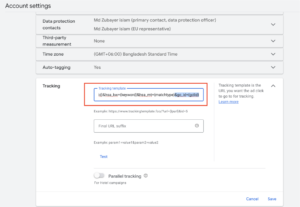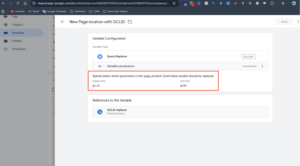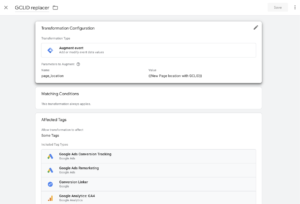Introduction
With the release of Safari 26, Apple’s new privacy update now targets tracking identifiers — including Google Click Identifier (GCLID) — which can break your Google Ads attribution and conversion tracking.
To fix this issue, you can protect your GCLID in Safari 26 by implementing Google Ads Server-Side Tracking using GTM (Google Tag Manager) and Stape.io.
This guide explains, step by step, how to use a custom query parameter to pass the click ID securely and ensure accurate conversion tracking across browsers.
Prerequisites
Before you begin, ensure the following setup is ready:
- Google Ads account (with conversion tracking enabled)
- Web & Server Google Tag Manager containers
- Stape.io account for server-side GTM hosting
- Your website connected to Web GTM
- Basic understanding of GA4 & Conversion Linker tags
Need Help?
Hire Me for Setup: WhatsApp Me
Book a Consultation: Schedule a Call
Step 1: Set Up the Custom Query Parameter in Google Ads
To start protecting your GCLID in Safari 26, configure a custom parameter in Google Ads.
- Navigate to your Google Ads account.
- Go to Admin → Account Settings → Tracking.
- Add a new query parameter to send the click ID.
- Use a custom name like ZC_ID (or any unique parameter name).
- This helps safely pass the click ID, since Safari 26 targets automatically generated GCLID parameters.

Step 2: Test the Custom Query Parameter
Now test if your custom query parameter works correctly before moving to server-side setup.
- Enter Preview Mode in your Web GTM container.
- In the preview URL, manually append a demo value, e.g. ?ZC_ID=DEMO_CLICK_ID
- Also, open Preview Mode in your Server GTM container.
- Connect to your website and check the incoming request in SGTM preview.
- You should see the page_location variable containing your URL with the custom parameter: …&ZC_ID=DEMO_CLICK_ID.
Step 3: Implement the Query Replacer Variable (Server GTM)
To fix the Safari 26 GCLID tracking issue, create a Query Replacer variable.
- In Server GTM, go to Variables → New Variable.
- Open the Template Gallery and search for Query Replacer (from Stape.io).
- Configure it as follows:
-
- Input: Capture data from the Page Location variable.
- Replace Query: Old query → ZC_ID, New query → GCLID.
- Input: Capture data from the Page Location variable.
- Save the variable (for example: Page Location with GCLID).

Step 4: Create and Apply a Transformation
Next, use the transformation feature in SGTM to apply the corrected query dynamically.
- In Server GTM, go to Transformations → New Transformation.
- Add a new row:
- Parameter Name: page_location
- New Value: Select the variable you created (Page Location with GCLID).
- Parameter Name: page_location
- Under Tags to Affect, choose all relevant tags depending on GCLID tracking:
- Google Ads Conversion Tag
- Google Remarketing Tag
- Conversion Linker Tag
- GA4 Event Tag
- Google Ads Conversion Tag
- Save and publish the transformation.

Step 5: Final Verification
Once the setup is complete, test your Google Ads Server-Side Tracking for Safari 26.
- Run Preview Mode on your Server GTM.
- Trigger a conversion event (like a form submission).
- In SGTM Preview, inspect tags such as Conversion Linker or Google Ads Conversion Tag.
- Verify that the page_location parameter now shows the transformed GCLID, confirming the replacement worked.
Frequently Asked Questions (FAQ)
Q1. Why is Safari 26 blocking GCLIDs?
👉 Safari 26 aims to block automatic tracking parameters like GCLID to enhance user privacy.
Q2. Can I still use the standard GCLID parameter?
👉 Not directly. You must send it via a custom parameter such as ZC_ID to prevent Safari from removing it.
Q3. Is this setup Google Ads compliant?
👉 Yes. You’re still using valid GCLID tracking through a server-side method.
Q4. Do I need Stape.io for this setup?
👉 Stape.io simplifies the GTM Server-Side setup, though self-hosting is also possible.
Q5. How can I confirm if the GCLID fix works?
👉 In Server GTM Preview, ensure page_location shows your custom GCLID value after form submission.
Conclusion
By following these five steps, you’ve successfully implemented Google Ads Server-Side Tracking using GTM and Stape.io to protect your GCLID in Safari 26.
✅ Key Benefits:
- Fixes Safari 26 GCLID tracking issue
- Maintains accurate conversion tracking
- Ensures privacy compliance
- Strengthens Google Ads attribution reliability
Now your campaigns will continue to track conversions precisely — even with Safari’s new restrictions.
🚀 Need help setting up GCLID Safari 26 Fix with Google Ads Server-Side Tracking and GTM Stape GCLID setup?



